Manage Client Keys¶

Note
This topic is about using the Chef management console to manage keys.
A client is an actor that has permission to access the Chef server. A client is most often a node (on which the chef-client runs), but is also a workstation (on which knife runs), or some other machine that is configured to use the Chef server API. Each request to the Chef server that is made by a client uses a private key for authentication that must be authorized by the public key on the Chef server.
Use the Chef management console to create a key pair, download the private key, and then set permissions, to delete a key, or to reset a key.
Manage Client Keys¶
Client keys can be managed from the Chef management console.
Warning
The images below refer to client keys as a “Client”.
Add¶
To add a client key:
Open the Chef management console.
Click Policy.
Click Clients.
Click Create.
In the Create Client dialog box, enter the name of the client key.

Click Create Client.
Copy the private key:
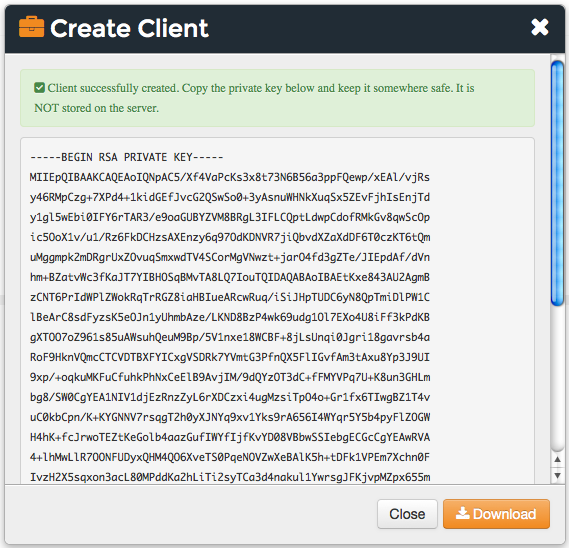
or download and save the private key locally:

Delete¶
To delete a client key:
Open the Chef management console.
Click Policy.
Click Clients.
Select a client key.
Click Delete.

Reset Key¶
To regenerate a client key:
Open the Chef management console.
Click Policy.
Click Clients.
Select a client key.
Click the Details tab.
Click Reset Key.
In the Reset Key dialog box, confirm that the key should be regenerated and click the Reset Key button:
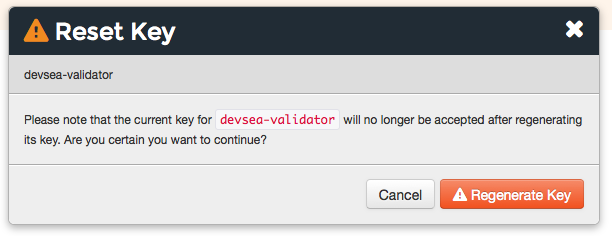
Copy the private key:
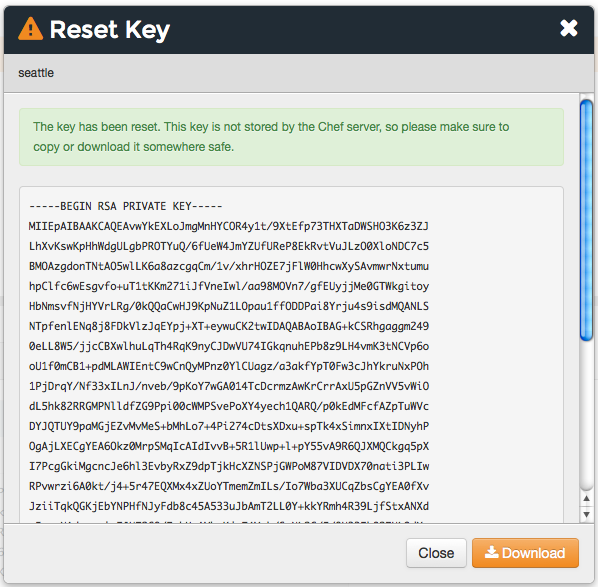
or download and save the private key locally:
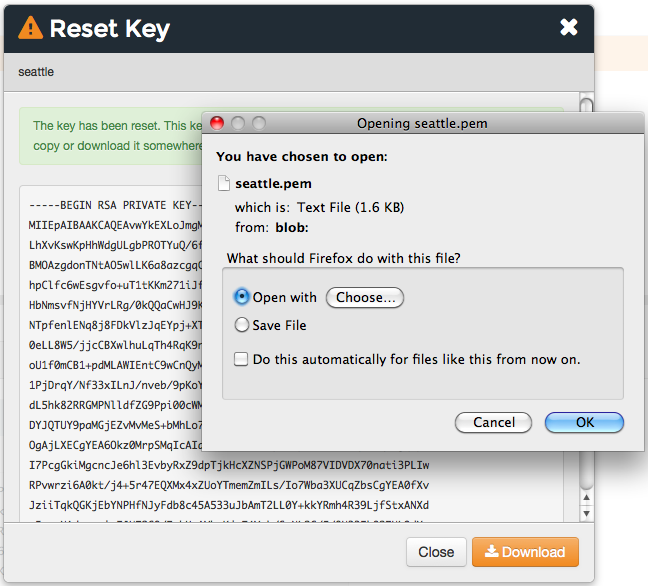
View Details¶
To view client key details:
- Open the Chef management console.
- Click Policy.
- Click Clients.
- Select a client key.
- Click the Details tab.
Permissions¶
Permissions are used in the Chef server to define how users and groups can interact with objects on the server. Permissions are configured per-organization.
The Chef server includes the following object permissions:
| Permission | Description |
|---|---|
| Delete | Use the Delete permission to define which users and groups may delete an object. This permission is required for any user who uses the knife [object] delete [object_name] argument to interact with objects on the Chef server. |
| Grant | Use the Grant permission to define which users and groups may configure permissions on an object. This permission is required for any user who configures permissions using the Administration tab in the Chef management console. |
| Read | Use the Read permission to define which users and groups may view the details of an object. This permission is required for any user who uses the knife [object] show [object_name] argument to interact with objects on the Chef server. |
| Update | Use the Update permission to define which users and groups may edit the details of an object. This permission is required for any user who uses the knife [object] edit [object_name] argument to interact with objects on the Chef server and for any chef-client to save node data to the Chef server at the conclusion of a chef-client run. |
Set¶
To set permissions list for a client key:
- Open the Chef management console.
- Click Policy.
- Click Clients.
- Select a client key.
- Click the Permissions tab.
- For each group listed under Name, select or de-select the Read, Update, Delete, and Grant permissions.
Update¶
To update the permissions list for a client key:
- Open the Chef management console.
- Click Policy.
- Click Clients.
- Select a client key.
- Click the Permissions tab.
- Click the + Add button and enter the name of the user or group to be added.
- Select or de-select Read, Update, Delete, and Grant to update the permissions list for the user or group.
View¶
To view permissions for a client key:
- Open the Chef management console.
- Click Policy.
- Click Clients.
- Select a client key.
- Click the Permissions tab.
- Set the appropriate permissions: Delete, Grant, Read, and/or Update.
chef-validator Keys¶
Every request made by the chef-client to the Chef server must be an authenticated request using the Chef server API and a private key. When the chef-client makes a request to the Chef server, the chef-client authenticates each request using a private key located in /etc/chef/client.pem.
However, during the first chef-client run, this private key does not exist. Instead, the chef-client will attempt to use the private key assigned to the chef-validator, located in /etc/chef/validation.pem. (If, for any reason, the chef-validator is unable to make an authenticated request to the Chef server, the initial chef-client run will fail.)
During the initial chef-client run, the chef-client will register with the Chef server using the private key assigned to the chef-validator, after which the chef-client will obtain a client.pem private key for all future authentication requests to the Chef server.
After the initial chef-client run has completed successfully, the chef-validator is no longer required and may be deleted from the node. Use the delete_validation recipe found in the chef-client cookbook (https://github.com/chef-cookbooks/chef-client) to remove the chef-validator.
Add¶
To add a chef-validator key:
Open the Chef management console.
Click Policy.
Click Clients.
Click Create.
In the Create Client dialog box, enter the name of the chef-validator key.
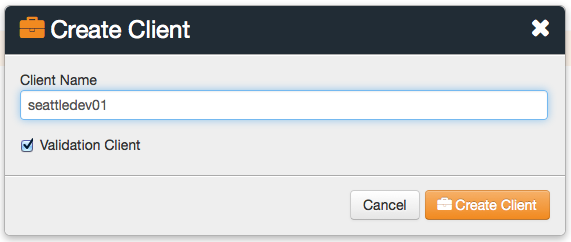
Select the Validation Client option. Click Create Client.
Copy the private key:

or download and save the private key locally:

Delete¶
To delete a chef-validator key:
Open the Chef management console.
Click Policy.
Click Clients.
Select a chef-validator key.
Click Delete.
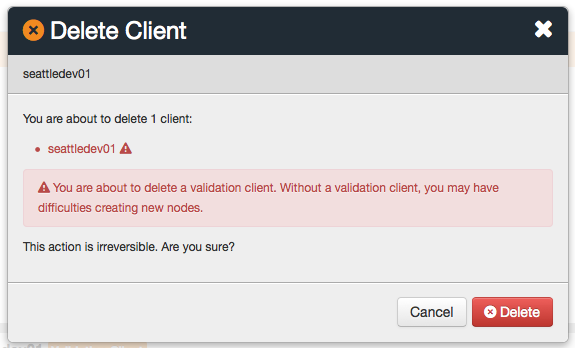
Reset Key¶
To reset a chef-validator key:
Open the Chef management console.
Click Policy.
Click Clients.
Select a chef-validator key.
Click the Details tab.
Click Reset Key.
In the Reset Key dialog box, confirm that the key should be regenerated and click the Reset Key button:

Copy the private key:

or download and save the private key locally:

View Details¶
To view details for a chef-validator key:
Open the Chef management console.
Click Policy.
Click Clients.
Select a chef-validator key.

Click the Details tab.
Permissions¶
Permissions are used in the Chef server to define how users and groups can interact with objects on the server. Permissions are configured per-organization.
The Chef server includes the following object permissions:
| Permission | Description |
|---|---|
| Delete | Use the Delete permission to define which users and groups may delete an object. This permission is required for any user who uses the knife [object] delete [object_name] argument to interact with objects on the Chef server. |
| Grant | Use the Grant permission to define which users and groups may configure permissions on an object. This permission is required for any user who configures permissions using the Administration tab in the Chef management console. |
| Read | Use the Read permission to define which users and groups may view the details of an object. This permission is required for any user who uses the knife [object] show [object_name] argument to interact with objects on the Chef server. |
| Update | Use the Update permission to define which users and groups may edit the details of an object. This permission is required for any user who uses the knife [object] edit [object_name] argument to interact with objects on the Chef server and for any chef-client to save node data to the Chef server at the conclusion of a chef-client run. |
Set¶
To update the permissions list for a chef-validator key:
- Open the Chef management console.
- Click Policy.
- Click Clients.
- Select a chef-validator key.
- Click the Permissions tab.
- Click the + Add button and enter the name of the user or group to be added.
- Select or de-select Delete, Grant, Read, and/or Update to update the permissions list for the user or group.
Update¶
To update the permissions list for a client key:
- Open the Chef management console.
- Click Policy.
- Click Clients.
- Select a client key.
- Click the Permissions tab.
- Click the + Add button and enter the name of the user or group to be added.
- Select or de-select Read, Update, Delete, and Grant to update the permissions list for the user or group.
View¶
To view permissions for a chef-validator key:
- Open the Chef management console.
- Click Policy.
- Click Clients.
- Select a chef-validator key.
- Click the Permissions tab.
- Set the appropriate permissions: Delete, Grant, Read, and/or Update.

